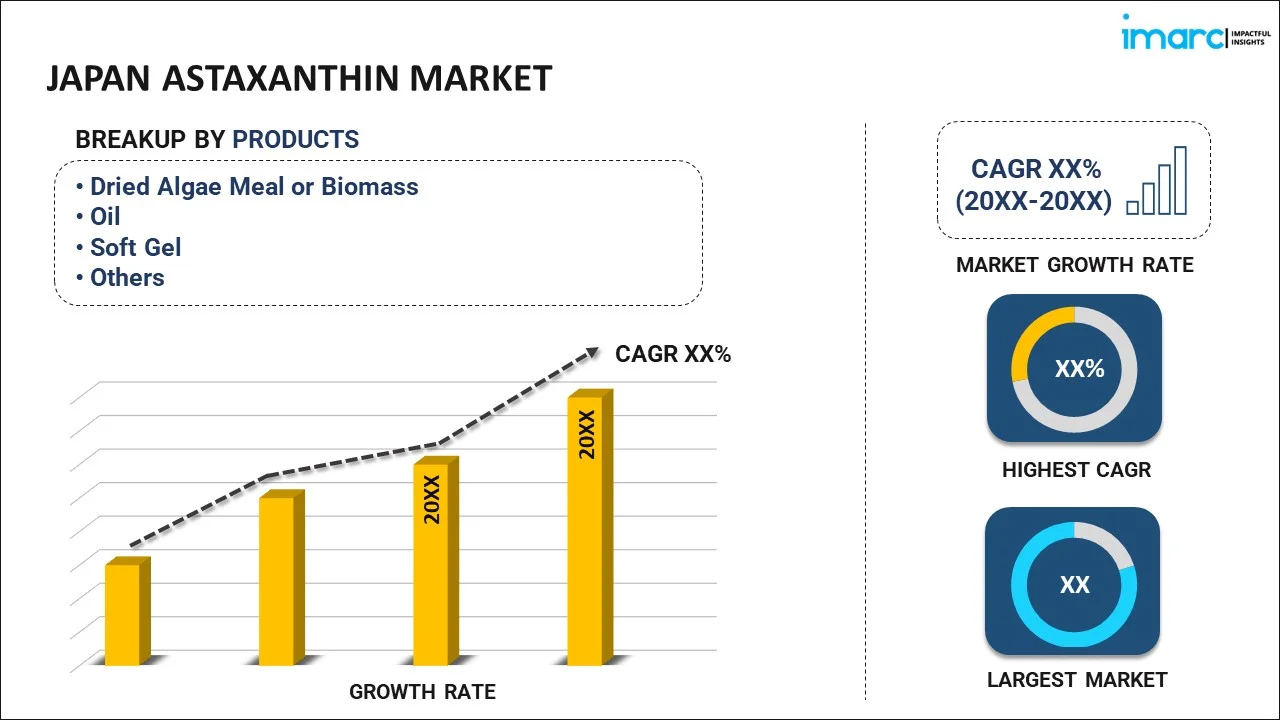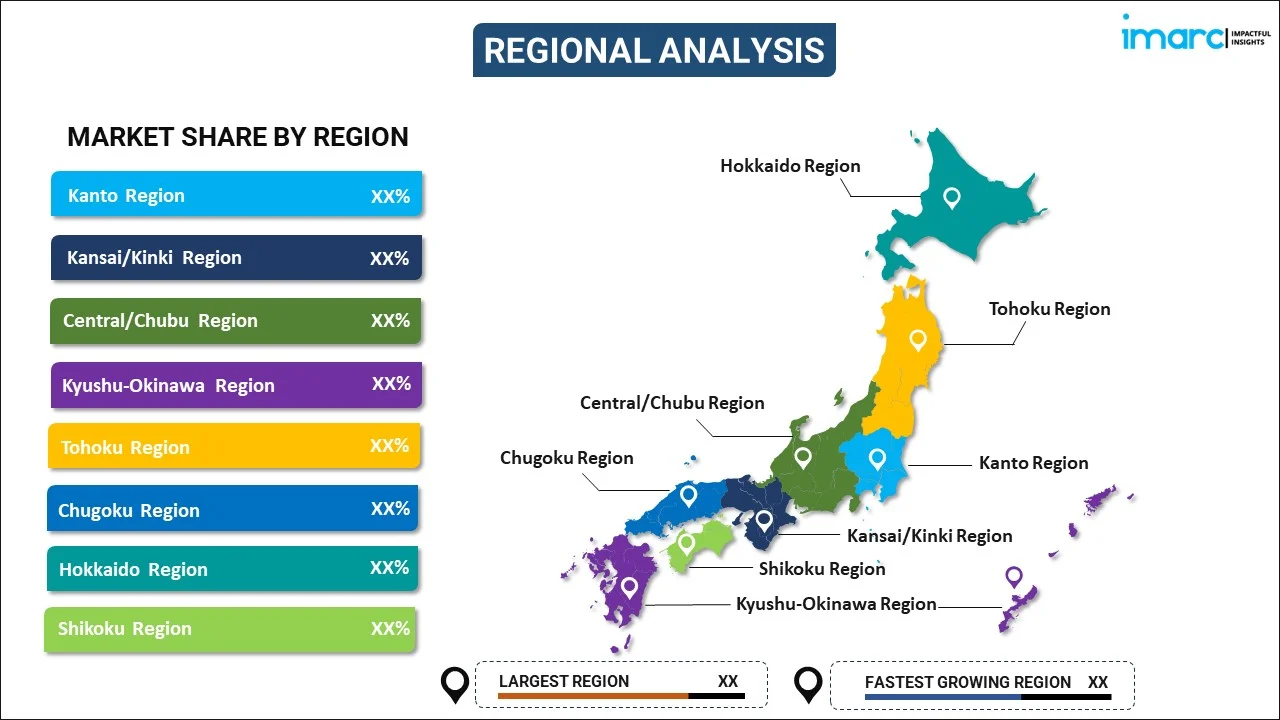
Japan Astaxanthin Market Report by Product (Dried Algae Meal or Biomass, Oil, Soft Gel, Liquid, and Others), Source (Natural, Synthetic), Application (Nutraceuticals, Cosmetics, Aquaculture and Animal Feed, and Others), and Region 2025-2033
Market Overview:
Japan astaxanthin market size reached USD 52.0 Million in 2024. Looking forward, IMARC Group expects the market to reach USD 169.0 Million by 2033, exhibiting a growth rate (CAGR) of 14.1% during 2025-2033. The escalating demand for dietary supplements, along with the increasing prevalence of health-related conditions, is primarily driving the market growth.
|
Report Attribute
|
Key Statistics
|
|---|---|
|
Base Year
|
2024 |
|
Forecast Years
|
2025-2033
|
|
Historical Years
|
2019-2024
|
| Market Size in 2024 | USD 52.0 Million |
| Market Forecast in 2033 | USD 169.0 Million |
| Market Growth Rate (2025-2033) | 14.1% |
Astaxanthin (C40H52O4) is a red, lipid-soluble carotenoid pigment present in various microorganisms and marine creatures. It falls within the category of chemical compounds known as terpenes, which are derived from five-carbon precursors, namely dimethylallyl diphosphate and isopentenyl diphosphate. Astaxanthin possesses attributes as an antioxidant, anti-inflammatory agent, and anticancer substance. These properties contribute to the enhancement of the immune system, protection against damage caused by ultraviolet (UV) radiation, prevention of chemically induced cancers, and treatment of various ailments. As a result, it finds application as a functional ingredient in food, a dietary supplement, and an additive in animal feed throughout Japan.
Japan Astaxanthin Market Trends:
In the context of the Japanese market, the significant growth of the astaxanthin market can be attributed to the rising incidence of various health conditions, such as diabetes, cancer, cognitive health issues, and cardiovascular diseases. Astaxanthin plays a crucial role in increasing blood circulation, reducing blood sugar levels, and alleviating muscle, joint, and tendon pain. Furthermore, it offers benefits like photoprotection against aging effects, improved sleep patterns, alleviation of depression, and enhanced sperm motility. Additionally, the escalating demand for astaxanthin as a food additive and food coloring agent within the global food and beverage (F&B) industry is notable. Astaxanthin's ability to preserve the taste, color, freshness, and overall quality of food products has led to a significant surge in its usage. Moreover, astaxanthin finds extensive application in skin care, contributing to skin tightening, reduction of fine lines and wrinkles, and the retention of moisture and elasticity. Manufacturers are adopting cost-effective technologies that prioritize water conservation and energy efficiency, such as sealed microalgae cultivation systems. These systems minimize the risks associated with microbial contamination and agricultural residues, further boosting market growth. Furthermore, factors like the growing preference for dietary supplements and the increasing prevalence of nutritional deficiencies among individuals are expected to drive market expansion in Japan over the forecasted period.
Japan Astaxanthin Market Segmentation:
IMARC Group provides an analysis of the key trends in each segment of the market, along with forecasts at the country level for 2025-2033. Our report has categorized the market based on product, source, and application.
Product Insights:

- Dried Algae Meal or Biomass
- Oil
- Soft Gel
- Liquid
- Others
The report has provided a detailed breakup and analysis of the market based on the product. This includes dried algae meal or biomass, oil, soft gel, liquid, and others.
Source Insights:
- Natural
- Yeast
- Krill/Shrimp
- Microalgae
- Others
- Synthetic
A detailed breakup and analysis of the market based on the source have also been provided in the report. This includes natural (yeast, krill/shrimp, microalgae, and others) and synthetic.
Application Insights:
- Nutraceuticals
- Cosmetics
- Aquaculture and Animal Feed
- Others
The report has provided a detailed breakup and analysis of the market based on the application. This includes nutraceuticals, cosmetics, aquaculture and animal feed, and others.
Regional Insights:

- Kanto Region
- Kansai/Kinki Region
- Central/ Chubu Region
- Kyushu-Okinawa Region
- Tohoku Region
- Chugoku Region
- Hokkaido Region
- Shikoku Region
The report has also provided a comprehensive analysis of all the major regional markets, which include Kanto Region, Kansai/Kinki Region, Central/ Chubu Region, Kyushu-Okinawa Region, Tohoku Region, Chugoku Region, Hokkaido Region, and Shikoku Region.
Competitive Landscape:
The market research report has also provided a comprehensive analysis of the competitive landscape in the market. Competitive analysis such as market structure, key player positioning, top winning strategies, competitive dashboard, and company evaluation quadrant has been covered in the report. Also, detailed profiles of all major companies have been provided.
Japan Astaxanthin Market Report Coverage:
| Report Features | Details |
|---|---|
| Base Year of the Analysis | 2024 |
| Historical Period | 2019-2024 |
| Forecast Period | 2025-2033 |
| Units | Million USD |
| Scope of the Report | Exploration of Historical Trends and Market Outlook, Industry Catalysts and Challenges, Segment-Wise Historical and Future Market Assessment:
|
| Products Covered | Dried Algae Meal or Biomass, Oil, Soft Gel, Liquid, Others |
| Sources Covered |
|
| Applications Covered | Nutraceuticals, Cosmetics, Aquaculture and Animal Feed, Others |
| Regions Covered | Kanto Region, Kansai/Kinki Region, Central/ Chubu Region, Kyushu-Okinawa Region, Tohoku Region, Chugoku Region, Hokkaido Region, Shikoku Region |
| Customization Scope | 10% Free Customization |
| Post-Sale Analyst Support | 10-12 Weeks |
| Delivery Format | PDF and Excel through Email (We can also provide the editable version of the report in PPT/Word format on special request) |
Key Questions Answered in This Report:
- How has the Japan astaxanthin market performed so far and how will it perform in the coming years?
- What has been the impact of COVID-19 on the Japan astaxanthin market?
- What is the breakup of the Japan astaxanthin market on the basis of product?
- What is the breakup of the Japan astaxanthin market on the basis of source?
- What is the breakup of the Japan astaxanthin market on the basis of application?
- What are the various stages in the value chain of the Japan astaxanthin market?
- What are the key driving factors and challenges in the Japan astaxanthin?
- What is the structure of the Japan astaxanthin market and who are the key players?
- What is the degree of competition in the Japan astaxanthin market?
Key Benefits for Stakeholders:
- IMARC’s industry report offers a comprehensive quantitative analysis of various market segments, historical and current market trends, market forecasts, and dynamics of the Japan astaxanthin market from 2019-2033.
- The research report provides the latest information on the market drivers, challenges, and opportunities in the Japan astaxanthin market.
- Porter's five forces analysis assist stakeholders in assessing the impact of new entrants, competitive rivalry, supplier power, buyer power, and the threat of substitution. It helps stakeholders to analyze the level of competition within the Japan astaxanthin industry and its attractiveness.
- Competitive landscape allows stakeholders to understand their competitive environment and provides an insight into the current positions of key players in the market.
Need more help?
- Speak to our experienced analysts for insights on the current market scenarios.
- Include additional segments and countries to customize the report as per your requirement.
- Gain an unparalleled competitive advantage in your domain by understanding how to utilize the report and positively impacting your operations and revenue.
- For further assistance, please connect with our analysts.

 Inquire Before Buying
Inquire Before Buying
 Speak to an Analyst
Speak to an Analyst
 Request Brochure
Request Brochure
 Request Customization
Request Customization



.webp)




.webp)












